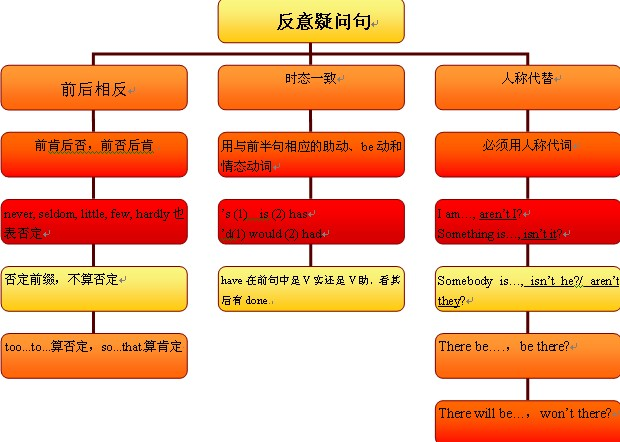本试题 “— I couldn't get through to you at home last night. You must have gone out then, ________?— Yes, I went to the cinema.[ ]A. mustn't youB. haven't y...” 主要考查您对反意疑问句
等考点的理解。关于这些考点您可以点击下面的选项卡查看详细档案。
- 反意疑问句
反意疑问句的概念:
表示提问人的看法,没有把握,需要对方证实。
反意疑问句由两部分组成:前一部分是一个陈述句,后一部分是一个简短的疑问句,两部分的人称时态应保持一致。
1、陈述部分肯定式+疑问部分否定式,可记为前肯后否。
2、陈述部分否定式+疑问部分肯定式,可记为前否后肯。
例如:This pencil is red, isn't it? Yes, it is. / No, it isn't.
This pencil isn't red, is it? Yes, it is. / No, it isn't.
反意疑问句类型:
1)陈述部分的主语是I,疑问部分要用aren't I.
如:I'm as tall as your sister, aren't I?
2)陈述部分的谓语是wish,疑问部分要用may+主语。
如:I wish to have a word with you, may I?
3)陈述部分用no, nothing, nobody, never, few, seldom, hardly, rarely, little等否定含义的词时,疑问部分用肯定含义。
如:The Swede made no answer, did he/she?
Some plants never blown(开花), do they?
4)含有oughtto的反意疑问句,陈述部分是肯定的,疑问部分用shouldn't/oughtn't+主语。
如:He ought to know what to do,oughtn't he?/shouldn't he?
5)陈述部分有have to+v.(had to+v.),疑问部分常用don't+主语(didn't+主语)。
如:We have to get there at eight tomorrow, don't we?
6)陈述部分的谓语是usedto时,疑问部分用didn't+主语或usedn't+主语。
如:He used to take pictures there, didn't he?/usedn't he?
7)陈述部分有had better+v. 疑问句部分用hadn't you?
如:You'd better read it by yourself, hadn't you?
8)陈述部分有would rather+v.,疑问部分多用wouldn't+主语。
如:He would rather read it ten times than recite it, wouldn't he?
9)陈述部分有You'd like to+v.疑问部分用wouldn't+主语。
如:You'd like to go with me, wouldn't you?
10)陈述部分有must的疑问句,疑问部分根据实际情况而定。
如:He must be a doctor, isn't he?
You must have studied English for three years, haven't you?/didn't you?
He must have finished it yesterday, didn't he?
反意疑问句用法总结:
| 陈述部分的谓语 | 疑问部分 |
| I' | aren’t I |
| wish | may + 主语 |
| no, nothing, nobody, never, few, seldom, hardly, rarely, little等否定含义的词 | 肯定含义 |
| ought to(肯定的) | shouldn't/ oughtn't +主语 |
| have to+v.(had to+v.) | don't +主语(didn't +主语) |
| used to | didn't +主语或 usedn't +主语 |
| had better + v. | hadn't you |
| would rather + v. | wouldn't +主语 |
| you'd like to + v. | wouldn't +主语 |
| must | 根据实际情况而定 |
| 感叹句中 | be +主语 |
| neither…nor, either…or 连接的并列主语 | 根据其实际逻辑意义而定 |
| 指示代词或不定代词everything, that, nothing, this | 主语用it |
| 并列复合句 | 谓语根据邻近从句的谓语而定 |
| 定语从句,宾语从句的主从复合句 | 根据主句的谓语而定 |
| think, believe, expect, suppose, imagine等引导 | 与宾语从句相对应的从句 |
| everybody, anyone, somebody, nobody, no one | 复数they, 单数he |
|
情态动词dare或need dare, need 为实义动词 |
need (dare ) +主语 do +主语 |
|
省去主语的祈使句 Let's 开头的祈使句 |
will you?shall we? |
| there be | 相应的谓语动词+there(省略主语代词) |
| 否定前缀不能视为否定词 | 仍用否定形式 |
| must表"推测" | 根据其推测的情况来确定反意疑问句 |
反意疑问句特殊用法点拨:
1、感叹句中,疑问部分用be+主语。
如:What colours, aren't they?
What a smell, isn't it?
2、陈述部分由neither...nor, either...or 连接的并列主语时,疑问部分根据其实际逻辑意义而定。
如:Neither you nor I am engineer, are we?
3、陈述部分主语是指示代词或不定代词everything, that, nothing, this,疑问部分主语用it。
如:Everything is ready, isn't it?
4、陈述部分为主语从句或并列复合句,疑问部分有三种情况:
a.并列复合句疑问部分,谓语动词根据邻近从句的谓语而定。
如:Mr. Smith had been to Bei jing for several times, he should have been in China now, shouldn't he?
b.带有定语从句,宾语从句的主从复合句,疑问部分谓语根据主句的谓语而定。
如:He is not the man who gave us a talk, is he?
He said he wanted to visit Japan, didn't he?
c.上述部分主句谓语是think, believe, expect, suppose, imagine等引导的定语从句,疑问部分与宾语从句相对应构成反意疑问句。
如:I don't think he is bright, is he?
We believe she can do it better, can't she?
5、陈述部分主语是不定代词everybody, anyone, somebody, nobody, noone等,疑问部分常用复数they,有时也用单数he。
如:Everyone knows the answer, don't they?(doeshe?)
Nobody knows about it, do they?(doeshe?)
6、带情态动词dare或need的反意疑问句,疑问部分常用need(dare)+主语。
如:We need not do it again, need we?
He dare not say so,dare you? 当dare, need为实义动词时,疑问部分用助动词do+主语。
如:She doesn't dare to go home alone, does she?
7、省去主语的祈使句的反意疑问句,疑问部分用will you。
如:Don't do that again, will you?
Go with me, will you/won't you? 注意:Let's开头的祈使句,后用shall we? Let us开头的祈使句,后用will you?
如:Let's go and listen to the music, shall we?
Let us wait for you in the reading-room, will you?
8、陈述部分是"therebe"结构的,疑问部分用there省略主语代词。
如:There is something wrong with your watch, isn't there?
There will not be any trouble, will there?
9、否定前缀不能视为否定词,其反意疑问句仍用否定形式。
如:It is impossible, isn't it?
He is not unkind to his classmates, is he?
10、must在表"推测"时,根据其推测的情况来确定反意疑问句。
如:He must be there now, isn't he?
It must be going to rain tomorrow, won't it?
反意疑问句知识体系:

复合句的反意疑问句:
1、当陈述部分是一个(带that引导宾语从句的)主从复合句时,附加疑问句的主谓要和主句的主谓保持对应关系。但是,当陈述部分的主语是:I suppose, I think, I believe, I imagine, I expect等结构时,附加疑问句的主语和谓语要和从句的主语,谓语保持一致关系。而且要注意到否定的转移问题。
如:I think there is something wrong with the washer, isn't there?
We don't suppose he cares, does he?
2、当陈述部分是I'm sure that;we are sure;I'm afraid that;We are sure that;I feel sure that等后面跟宾语从句时,反意疑问句与后面的宾语从句一致。
3、当陈述部分是并列句时,附加疑问句的主谓语要和离它最近的句子的主谓保持对应关系。
如:We must redouble our efforts, or we'll not be able to catch up with the others, will we?
与“— I couldn't get through to you at home last night. You m...”考查相似的试题有:
- .I don’t believe everything goes well with you,____?A.do theyB.does itC.don’t theyD.doesn’t it
- He must be helping the old man to water the flowers,______ ? A.is heB.isn’t heC.must heD.mustn’t he
- I don't think the bottle's broken, ______? A.is itB.hasn't itC.has itD.isn't it
- —What a fine day, isn’t it— .A.Is that soB.I like the weatherC.Yes, isn’t itD.But it’s not
- —I suppose he’ll pass the exam, _______________? —Of course he will.A.will heB.won’t heC.don’t ID.do I
- ----Mr. Li told me once he had a fall and broke his leg .----_______was that.A Since when B For how long C How long a...
- There’s nothing more important than good health, _______?A.is thereB.isn’t itC.isn’t thereD.is it
- I suppose that there used to be a fairy in the woods, _______?A.aren’t IB.doesn’t sheC.didn’t itD.didn’t there
- -_______do you spare time to visit your parents every month?-Twice.A.How longB.How oftenC.How soonD.How fast
- Not everyone likes everyone else, ___________?A.does oneB.does everyoneC.do theyD.don’t they